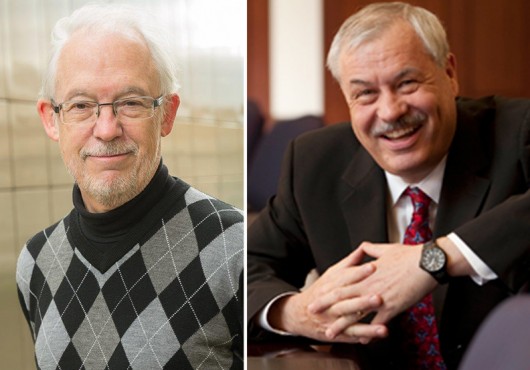
(Left) Martin Tusler, a research specialist in psychology at OSU, (Right) Rene Stulz, the Everett D. Reese Chair of Banking and Monetary Economics at OSU’s Fisher College of Business.
Credit: Courtesy of OSU
To become influential, a researcher doesn’t just have to do research and write papers — they have to get noticed.
That’s the premise behind 13 Ohio State researchers being recognized as influential in their fields of study based on their peers’ citations.
Thomson Reuters, a media and information firm, found these faculty members ranked in the top 1 percent for the number of citations made by their peers. The findings were based on journal papers published between 2002 and 2012.
Janet Weisenberger, senior associate vice president for research in OSU’s Office of Research, said in an email that she is “delighted to see this recognition.”
“It is not surprising that a number of our faculty are on the list, because Ohio State is a top research university and our researchers are making amazing discoveries every day,” she said.
Weisenberger said the citations are most commonly made by other researchers working in the same area of study, and are tracked by database tools that check publications in scholarly journals, but they do not differentiate between citations in papers published by faculty and papers published by student authors. Papers submitted for courses or other writings that are just posted on the web do not count toward the citations.
Weisenberger said citations are an important “indication of how widely read a paper is, as well as an indication of how influential the paper is for subsequent research.” This is one way of estimating the national and international reputation of a researcher.
Martin Tusler, a research specialist in psychology at OSU, was one of the 13 researchers recognized for their influence.
Tusler said in an email that he has been the author of 20 articles and those articles have been cited 1,143 times by other researchers.
His publications fall into three areas, he said.
“Originally, I worked with professor Judith Hibbard, at the time at the University of Oregon. Our papers together look at two topics. We looked at how engaged patients are in their personal healthcare. Secondly, she and I did studies of how public reporting of hospital performance information changes how they attempt to improve their quality of care. Finally, I worked with professor Ellen Peters here at Ohio State on the ways in which numeric ability influences decision making,” Tusler said.
Tusler acted as data analyst for each of the publications and helped in the writing the articles.
Another recognized researcher is René Stulz, the Everett D. Reese Chair of Banking and Monetary Economics at OSU’s Fisher College of Business.
Even though he has published more than 60 papers in finance and economic journals, the number of publications is irrelevant for the rankings, he said in an email.
“The ranking is based on the citation of papers. So, if you published 100 papers but nobody cited them, you would not show up. If you have one paper but it is extremely influential, you could show up,” he said.
Stulz’s works that have had the most influence are a paper that shows that “large acquisitions during the merger wave of the late 1990s destroyed a considerable amount of shareholder wealth,” and a paper that “documents that cash holdings of corporations have increased dramatically since 1980.”
Weisenberger also noted that citations are only one estimate of a scholar’s reputation and “it can take several years for the true impact of a scholarly work to be reflected in a citation count.”
Other OSU researchers to make the cut include:
- William Abraham, professor cardiovascular medicine
- Hojjat Adeli, professor of civil, environmental and geodetic engineering
- Hansjuerg Alder, research professor of molecular virology, immunology and medical genetics
- Clara Bloomfield, distinguished university professor and William G. Pace III Professor of Cancer Research
- Carlo Croce, professor and chair of molecular virology, immunology and medical genetics, director of human cancer genetics and holder of the John W. Wolfe Chair in Human Cancer Genetics
- Hesham El Gamal, professor of electrical and computer engineering
- Rattan Lal, distinguished university professor of soil science
- Guido Marcucci, professor of hematology
- Ness Shroff, professor and Ohio Eminent Scholar, computer science and engineering
- Stefano Volinia, associate professor of molecular virology, immunology and medical genetics
- David Weinberg, Henry L. Cox professor of astronomy and distinguished professor of mathematical and physical sciences


